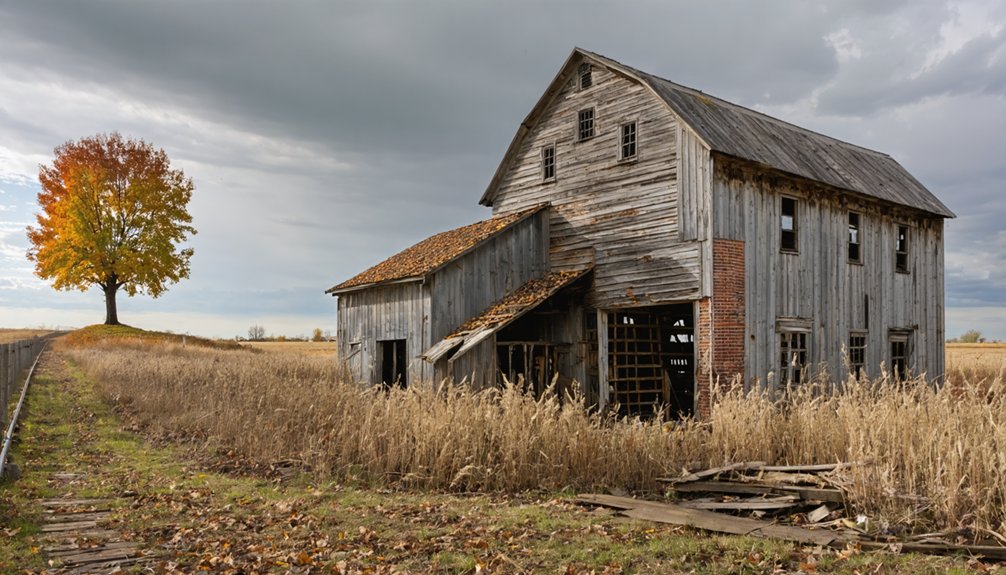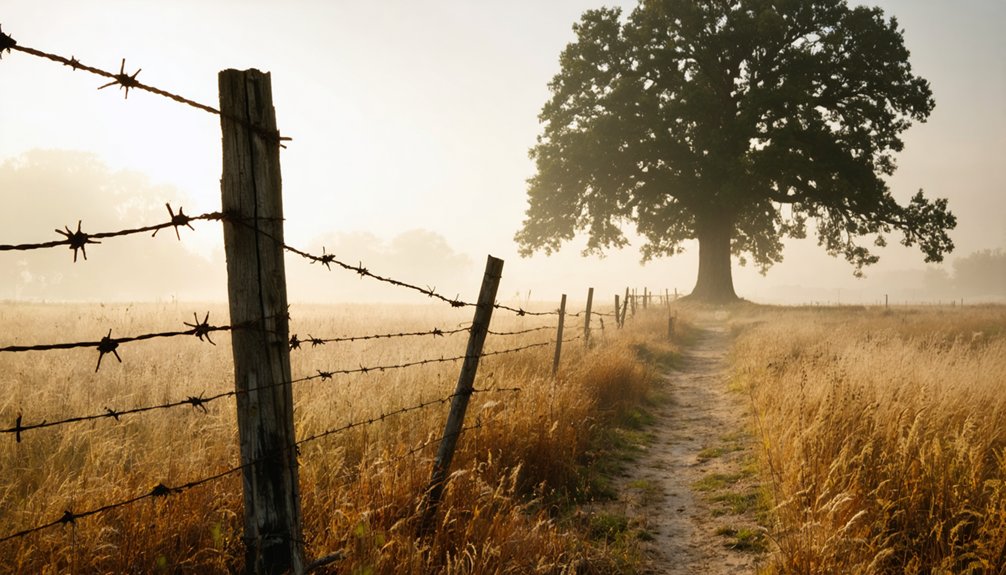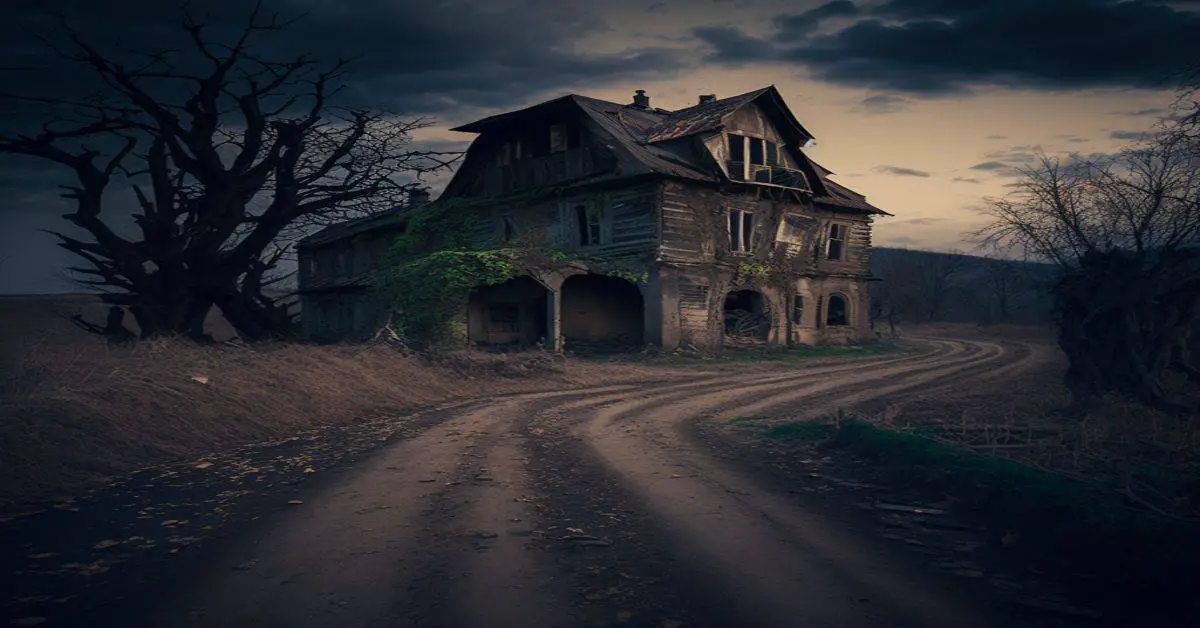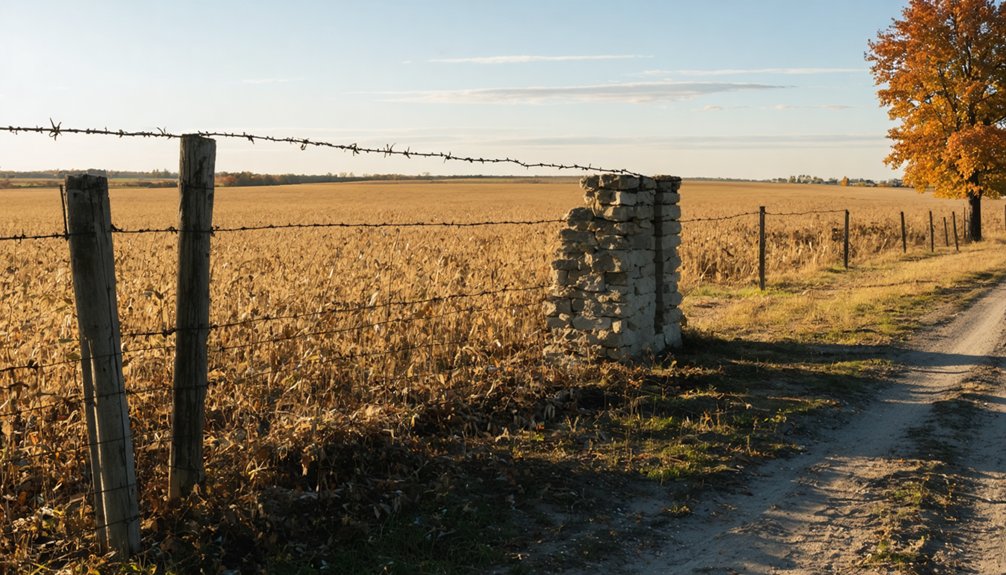You’ll find Brush Point’s ghost town story along the western bank of Illinois’ Kishwaukee River, where settlers built log cabins in 1830. Led by Dr. Henry Madden, this frontier community made an ambitious bid to become DeKalb County’s seat in 1839, but lost to Sycamore due to concerns over flooding. The settlement’s flood-prone location ultimately sealed its fate, and today only the former Brush Point School remains as evidence of this once-promising pioneer town.
Key Takeaways
- Brush Point was established in 1830 along the Kishwaukee River in DeKalb County, Illinois, as a frontier settlement.
- The town’s decline began after losing the 1839 county seat bid to Sycamore due to concerns about flooding.
- Frequent flooding from the Kishwaukee River destroyed wooden structures and led to gradual abandonment of the settlement.
- No original structures remain except the former Brush Point School, with the area now converted to farmland.
- Located at 42°01′41″N and 88°45′13″W, Brush Point existed briefly before environmental challenges led to its ghost town status.
The Rise and Fall of a Frontier Settlement
While many frontier settlements flourished in 1830s Illinois, Brush Point’s story serves as a cautionary tale of unfulfilled potential.
Initial settlers built crude log cabins along the riverbank to establish their homesteads. You’ll find its origins along the western bank of the Kishwaukee River, where settlers built log houses and established a tight-knit community in 1830. The settlement patterns followed typical frontier development, with residents drawn to the river’s resources for farming and transportation. Dr. Madden’s election as Representative to Legislature in 1836 brought political influence to the growing settlement.
The community dynamics shifted dramatically in 1839 when Brush Point vied for county seat status, championed by the influential Dr. Henry Madden.
When Sycamore won the bid, largely due to Brush Point’s flood-prone location, the settlement’s fate was sealed. Residents gradually abandoned their homes, moving to more promising locations, and the once-hopeful frontier town faded into history, becoming one of Illinois’ ghost towns.
Geographic Location and Natural Features
Located at 42°01′41″N and 88°45′13″W in DeKalb County’s Mayfield Township, Brush Point sits on the western bank of the Kishwaukee River, about 5 miles northwest of Sycamore.
Nestled along the Kishwaukee River, Brush Point’s precise coordinates mark a forgotten settlement in DeKalb County’s rural landscape.
If you’d visited this frontier settlement during its heyday, you’d have found early pioneers adapting to the prairie landscape. River proximity influenced settlement patterns, with small log houses dotting the riverbank. While the location offered essential water access, it also sealed the town’s fate.
Here’s what shaped the natural environment:
- Low-lying terrain near the Kishwaukee River created flood-prone conditions
- Prairie grasslands stretched across gently rolling hills, interrupted by patches of timber
- Northern Illinois climate brought harsh winters and warm summers, challenging settlers’ resilience
The geographic isolation and recurring floods eventually led to the community’s abandonment.
The Failed County Seat Bid of 1839
In June 1839, you’d find Dr. Henry Madden, a prominent local physician and state legislator, leading Brush Point‘s bid to become DeKalb County’s seat of government.
Despite his political influence and active advocacy, Brush Point’s hopes were dashed after closed-door meetings among county decision-makers raised concerns about the site’s low-lying location near the Kishwaukee River. The settlement’s demise stands in stark contrast to modern digital platforms like creative design tools that help communities thrive.
The loss to Sycamore triggered an exodus of residents and businesses from Brush Point, setting the stage for the settlement’s eventual disappearance.
Political Power Struggle
During the summer of 1839, Brush Point found itself embroiled in a heated political battle for DeKalb County’s seat of government.
Political alliances formed quickly as Dr. Henry Madden, a state legislator and Brush Point’s champion, rallied support against rival factions from Coltonville and Sycamore. The region’s artists and craftspeople formed a creative community hub during this period of growth and opportunity.
The backroom dealings that followed would forever shape the region’s future. Rufus Colton’s cabin became the site of a controversial court meeting aimed at swaying the county seat decision.
You can imagine the intensity of this power struggle through these key moments:
- Closed-door meetings where influential figures traded promises and favors
- Dr. Madden’s impassioned speeches promoting Brush Point’s strategic location
- The devastating announcement that Sycamore had won, crushing Brush Point’s ambitions
The aftermath proved swift and harsh.
Many residents abandoned Brush Point for Sycamore, taking their dreams of prosperity with them.
This exodus marked the beginning of Brush Point’s gradual fade into obscurity.
Local Support Falters
While Dr. Henry Madden championed Brush Point’s bid for county seat status in 1839, you’ll find that local support began crumbling when harsh realities set in.
The settlement’s position along the Kishwaukee River, once seen as an advantage, proved to be its ultimate weakness. You can imagine the community’s growing concerns as flooding repeatedly threatened their homes and businesses, making it difficult to sustain a stable local economy.
As community dynamics shifted, residents couldn’t ignore the more practical appeal of Sycamore’s elevated location just five miles away. The prospect of building permanent county structures on Brush Point’s flood-prone terrain became increasingly unpopular.
Even with Madden’s political influence in the state legislature, you’d have seen how quickly support dwindled as citizens prioritized long-term security over local pride.
Life in Early Brush Point
Settled along the banks of the Kishwaukee River in DeKalb County, Illinois, Brush Point emerged as a small but vibrant community in 1830.
You’d find Dr. Henry Madden, a prominent political figure, leading community gatherings and shaping local policies. The settlement’s agricultural practices thrived thanks to the fertile riverbank soil, while the river itself opened trade routes to distant markets. The community established its official presence when Harrison Mackey became postmaster in 1855.
Living in early Brush Point, you’d experience:
- Log houses dotting the landscape, built by pioneering families seeking independence
- Children learning at the old Brush Point School, a centerpiece of community life
- Farmers working the rich soil while battling seasonal floods from the Kishwaukee
The settlement’s freedom-loving spirit showed through its self-sufficient residents who built their lives through farming, trading, and harvesting the abundant natural resources.
From Thriving Community to Ghost Town

You’ll find that Brush Point’s pivotal moment came in 1839 when it lost its bid to become the county seat to nearby Sycamore.
The defeat dealt a crushing blow to Dr. Henry Madden’s ambitious vision for the settlement, as businesses and residents began migrating to the more promising Sycamore just 5 miles southeast.
Without the economic opportunities and infrastructure that would have come with being the county seat, Brush Point’s once-thriving community gradually faded into obscurity, its wooden structures succumbing to the frequent floods from the nearby Kishwaukee River. Today, the area where Brush Point once stood has been transformed into endless farmland, with no remaining traces of the former settlement.
Failed County Seat Dreams
During the summer of 1839, Brush Point stood at a pivotal crossroads as it vied for the coveted position of DeKalb County seat. The community dynamics were shaped by Dr. Henry Madden‘s passionate advocacy, as he rallied support for this ambitious bid of historical significance.
You’ll find three striking elements that defined Brush Point’s county seat campaign:
- The town’s strategic location northwest of Sycamore positioned it as a natural administrative hub.
- Local residents united behind Dr. Madden’s vision for their community’s future.
- The Kishwaukee River’s proximity offered both opportunity and challenge through frequent flooding.
Ultimately, nature’s forces worked against Brush Point’s aspirations. The low-lying land’s susceptibility to flooding became a decisive factor, and when Sycamore won the bid, residents began their exodus toward more promising horizons.
Early Settlement Fades Away
The loss of the county seat bid marked the beginning of Brush Point’s swift decline from a hopeful settlement into a ghost town. You would’ve witnessed the pioneer lifestyle rapidly unraveling as families packed up their belongings and headed southeast to Sycamore, taking their dreams and investments with them.
The once-bustling community dynamics shifted dramatically. The small log houses that had sheltered early settlers like Dr. Henry Madden now stood empty, while the village’s population dwindled below sustainable levels.
Historical Landmarks and Remnants
Despite extensive searches for physical remnants of Brush Point’s past, only a single landmark with precise coordinates remains documented – the former site of Brush Point School at 42°01′41″N 88°45′13″W.
If you visit the abandoned settlement today, you’ll find agricultural fields where a once-promising community stood. Like many other lost Illinois communities, Brush Point has been converted to farmland over the decades.
The historical significance of this ghost town has been largely erased by time, with these stark reminders of its community structure:
Time’s unstoppable march has stripped away Brush Point’s legacy, leaving only faint echoes of the pioneer community that once thrived here.
- No original log houses remain along the western bank of the Kishwaukee River
- The flood-prone location shows no trace of the buildings that once stood there
- No historical markers or protected areas commemorate the former settlement
The site exists now only in historical records and local memory, a reflection of the impermanence of frontier settlements.
Legacy in DeKalb County History

While Brush Point‘s physical presence has vanished from DeKalb County’s landscape, its role in shaping the region’s early political landscape remains significant.
You’ll find its legacy most prominently in the 1839 county seat contest, where the settlement’s civic engagement, led by Dr. Henry Madden, challenged Sycamore’s bid for prominence.
The town’s ultimate fate tells a cautionary tale of how natural geography can determine a community’s destiny.
Though Brush Point’s dreams of becoming the county seat were washed away by flooding concerns along the Kishwaukee River, its story has enriched DeKalb County’s historical narrative.
The settlement’s brief but notable existence, marked by its schoolhouse and pioneering spirit, continues to influence local community identity and serves as a reminder of early Illinois settlers’ determination.
Frequently Asked Questions
What Happened to the Original Residents of Brush Point?
You’ll find the original residents relocated primarily to Sycamore, about five miles southeast, following population decline. They’d abandoned their homes due to persistent flooding and the lost county seat bid.
Are There Any Surviving Photographs of Brush Point During Its Peak?
You won’t find any surviving photographs of the settlement during its peak. Despite historical preservation efforts and archival research, the town disappeared before photography became widely available in rural Illinois.
Was Brush Point Ever Connected to the Railroad System?
You won’t find definitive records of railroad connections at this location. While Illinois’ transportation history shows extensive rail networks throughout the state, there’s no conclusive evidence of tracks reaching Brush Point.
Did Any Notable Historical Events or Figures Visit Brush Point?
You won’t find any major historical visitors to Brush Point. The only notable figure was Dr. Henry Madden, a local resident who served in the Illinois State Legislature in 1836.
What Native American Tribes Inhabited the Area Before Brush Point’s Establishment?
You’ll find the Potawatomi and Kickapoo tribes were the primary Native American inhabitants, settling there around 1765 after the Illinois Indians left, leaving their cultural heritage through scattered settlements and artifacts.
References
- https://en.wikipedia.org/wiki/Brush_Point
- https://drloihjournal.blogspot.com/2017/02/lost-towns-of-illinois-brush-point.html
- https://drloihjournal.blogspot.com/p/lost-towns-of-illinois-series.html
- https://en.wikipedia.org/wiki/List_of_ghost_towns_in_Illinois
- https://www.youtube.com/watch?v=93k0qtvzkn4
- https://libsysdigi.library.illinois.edu/OCA/Books2012-06/thehistoryofrand00mont/thehistoryofrand00mont.pdf
- https://iccharbinger.com/the-history-of-an-1840s-abandoned-mansion-and-the-failed-attempt-to-revive-it/
- https://storymaps.arcgis.com/stories/6ea7c4b9b0594c039c2792d5be7456c9
- https://mchistory.org/digital-exhibits/making-a-home/frontier/frontier-settlement
- https://drloihjournal.blogspot.com/2016/12/lost-towns-of-illinois-fullersburg.html



